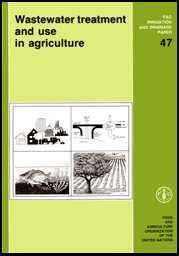Wastewater treatment and use in agriculture
 |
FAO irrigation and drainage paper 47
livre Jan 1992 ; 169 pages
Ed. FAO - Rome
Téléchargeable chez l'éditeur
Page de présentation d'un éditeur
Sommaire:
1. Wastewater characteristics and effluent quality parameters
1.1 Introduction
1.2 Characteristics of wastewaters
1.3 Quality parameters of importance in agricultural use of wastewaters
2. Wastewater quality guidelines for agricultural use
2.1 Introduction
2.2 Human exposure control
2.3 Effluent quality guidelines for health protection
2.4 Water quality guidelines for maximum crop production
2.5 Health protection measures in aquacultural use of wastewater
3. Wastewater treatment
3.1 The problem
3.2 Conventional wastewater treatment processes
3.2.1 Preliminary treatment
3.2.2 Primary treatment
3.2.3 Secondary treatment
3.2.4 Tertiary and/or advanced treatment
3.2.5 Disinfection
3.2.6 Effluent storage
3.2.7 Reliability of conventional and advanced wastewater treatment
3.3 Natural biological treatment systems
3.3.1 Wastewater stabilization ponds
3.3.2 Overland treatment of wastewater
3.3.3 Macrophyte treatment
3.3.4 Nutrient film technique
4. Aquifer recharge with wastewater
4.1 Principles
4.1.1 Soil-aquifer treatment (SAT)
4.1.2 SAT system layouts
4.1.3 Soil requirements
4.2 Operations
4.2.1 Hydraulic capacity and evaporation
4.2.2 Basin management
4.2.3 Pretreatment
4.3 Effects
4.3.1 Suspended solids
4.3.2 Organic compounds
4.3.3 Bacteria and viruses
4.3.4 Nitrogen
4.3.5 Phosphorus
4.3.6 Trace elements and salts
5. Irrigation with wastewater
5.1 Conditions for successful irrigation
5.1.1 Amount of water to be applied
5.1.2 Quality of water to be applied
5.1.3 Scheduling of irrigation
5.1.4 Irrigation methods
5.1.5 Leaching
5.1.6 Drainage
5.2 Strategies for managing treated wastewater on the farm
5.3 Crop selection
5.3.1 To overcome salinity hazards
5.3.2 To overcome toxicity hazards
5.3.3 To prevent health hazards
5.4 Selection of irrigation methods
5.5 Field management practices in wastewater irrigation
5.5.1 Water management
5.5.2 Land and soil management
5.5.3 Crop management and cultural practices
5.6 Planning for wastewater irrigation
5.6.1 Central planning
5.6.2 Desirable site characteristics
5.6.3 Crop selection issues
6. Agricultural use of sewage sludge
6.1 Characteristics of sewage sludge
6.2 Sludge treatment
6.3 Sludge application
6.4 Effects of sludge on soils and crops
6.5 Planting, grazing and harvesting constraints
6.6 Environmental protection
7. Wastewater use in aquaculture
7.1 Biota in aquaculture ponds
7.1.1 Food chains
7.1.2 Fish species
7.1.3 Aquatic plants
7.2 Technical aspects of fish culture
7.2.1 Environmental factors
7.2.2 Fish yields and population management
7.2.3 Health related aspects of fish culture
8. Economic, institutional and policy issues
8.1 Economic and financial implications
8.2 Institutional organization
8.3 Policy issues
9. Wastewater use case studies
9.1 Advanced wastewater treatment: California, USA
9.1.1 Reclaimed wastewater uses
9.1.2 Wastewater reclamation criteria
9.1.3 Wastewater treatment
9.1.4 Monterey wastewater reclamation study for agriculture
9.2 Wastewater treatment in stabilization ponds: Al Samra, Jordan
9.2.1 Septage pretreatment and wastewater transmission
9.2.2 Al Samra stabilization ponds
9.2.3 Performance of Al Samra stabilization ponds
9.3 Soil-aquifer treatment: Arizona, USA
9.3.1 Project details
9.3.2 Quality improvements
9.4 Wastewater treatment and crop restriction: Tunisia
9.4.1 Current and future use of wastewaters in Tunisia
9.4.2 Studies of treated wastewater irrigation and sewage sludge application
9.4.3 Legislation
9.5 Wastewater treatment and human exposure control: Kuwait
9.5.1 Background to treated effluent use in Kuwait
9.5.2 Master plan for effluent utilization
9.5.3 Project outputs and controls
9.6 Crop restriction for wastewater irrigation: Mexico
9.6.1 Historical use of sewage for irrigation
9.6.2 Mezquital valley irrigation district 03 experience
9.6.3 Health impacts
9.7 Wastewater use in aquaculture: Calcutta, India
9.7.1 The Calcutta system
9.7.2 Health impacts
Mot clef: |
Editeur/Diffuseur: |
|
FAO
-
Food and Agriculture Organization - Rome - Italie |
En cas de lien brisé, nous le mentionner à communication@pseau.org